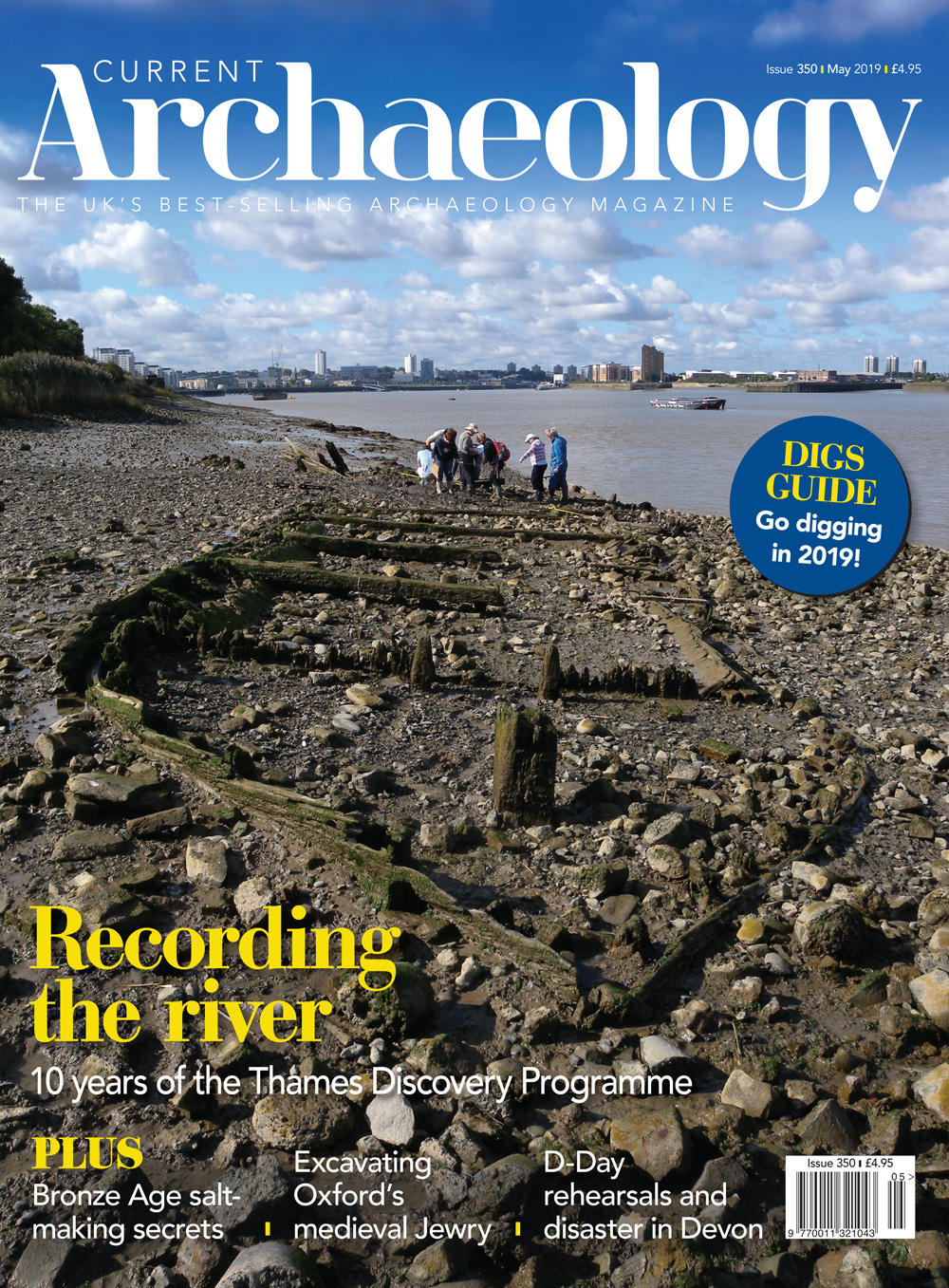Our cover story takes us to the longest archaeological ‘site’ in Britain: the banks of the River Thames. For ten years, Thames Discovery Programme members have been braving all weathers to record the refuse of centuries of Londoners and newly exposed archaeological features before they are swept away by the tidal river’s ebb and flow.
/nAmassed rubbish has also proved illuminating in Oxford city centre: there, archaeologists have been poring over 11th-to-15th-century dietary evidence, uncovering tantalising traces of the city’s medieval Jewish quarter.
/nSpeaking of food, salt has long been a key component of many a meal, and its manufacture stretches deep into our past. We visit Lincolnshire to explore some of the region’s Bronze Age salterns.
/nOur final feature focuses on rather more recent archaeology, taking us to the Devon coast and to preparations for D-Day 75 years ago. The Normandy landings were unprecedented in their scale and complexity, so full-scale rehearsals were planned for April 1944. While this exercise was vital for the operation’s ultimate success, the practice assault ended in disaster, with the loss not only of ships but of hundreds of lives. For years the tragedy was shrouded in secrecy, but recent archaeological work on the wreck site is helping to bring the story of Exercise Tiger to light once more.
IN THIS ISSUE:/n
FEATURES/n
YOU ARE WHAT YOU EAT?/n
/nExcavating the Oxford JewryPerceptions of Oxford usually revolve around ‘dreaming spires’ and the city’s famous university, but recent excavations in the city centre have illuminated other aspects of its rich past, including early Anglo-Saxon structures and rare traces of Oxford’s long-vanished medieval Jewish quarter.
BATTLING OLD FATHER THAMES/n
/nThe Thames Discovery Programme at tenFor the last decade, archaeologists and volunteers from the Thames Discovery Programme have worked tirelessly to record foreshore sites exposed by the waters of the Thames, racing against time before the fragile finds are eroded away. We explore some of the key highlights among their discoveries.
SALT OF THE EARTH/n
/nHow Lincolnshire transformed seawater into white goldToday, we take salt for granted, but its history stretches deep into our past. Spanning from the Middle Bronze Age into the medieval period, salt was produced in industrial quantities in Lincolnshire, leaving an indelible mark on the landscape.
EXERCISE TIGER/n
/nArchaeological echoes of rehearsals for the D-Day landingsD-Day was a massive, complex operation, the likes of which had never been attempted before. To get the details right, the Allied forces practised their assault on a Devon beach – but the rehearsals ended in disaster, and the loss of hundreds of lives. With the tragedy marking its 75th anniversary this month, maritime surveys are shedding new light on the wreck site.
NEWS/n
/nRitual protection marks identified at Creswell Crags; Conclusive chronologies at Carnoustie; Recording Roman graffiti near Hadrian’s Wall; Neolithic cranium found on the Thames foreshore; New insights into Irish bog butter; Science Notes; Investigating leprosy in Ireland; Finds Tray
REGULARS/n
/nCommentJoe Flatman excavates the CA archive
/nContextSupply and demand: Bradkirk Brickworks, Lancashire
/nDigs Guide 2019This special section gives a taste of the projects you can get involved in this summer
/nReviewsThe Times of their Lives: hunting history in the archaeology of Neolithic Europe; The First Foresters: explore the Neolithic in Scotland’s native woodlands; The Archaeology of Underground Mines and Quarries in England; Nineteenth Century Childhoods; The Reality of Artifacts: an archaeological perspective; Thurrock’s Deeper Past: a confluence of time
/nMuseumThe Egyptian Galleries at Bolton Museum
/nCalendarOur selection of exhibitions and events
/nConferenceA round-up of what happened at CA Live! 2019
/nSherdsChris Catling’s irreverent take on heritage issues
/nOdd SocsBox Archaeological and Natural History Society

